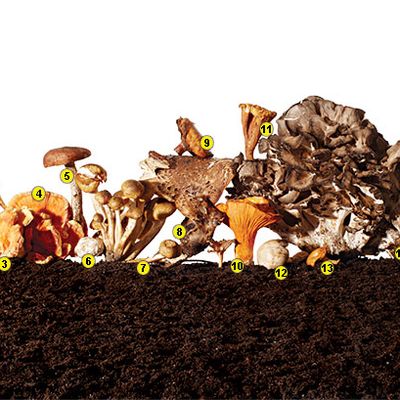
Despite misleading menuspeak, many foods that claim to be wild often aren’t: Venison. Boar. Salmon. That obfuscation partly explains the fanaticism sparked by the truly uncultivated object, like the wild mushroom, technically the fruiting body of a fungus so beloved it’s turned fans like Eugenia Bone, author of the fascinating Mycophilia, into brambles-braving, campground-scouring obsessives. Harvesting edible things in their natural habitat is having a bit of a (prolonged) moment in this locavore age, if New Nordic chefs like Noma’s René Redzepi and films like Now, Forager are any indication. But there are those who regard the notion of foraging as mere sourcing-one-upmanship, and reject the word altogether, pointing to its overlooked etymology: to strip or ravage. Wildcrafters like Nova Kim and Les Hook of Vermont’s Wild Food Gatherers Guild, conversely, advocate for collecting plants ethically and sustainably, mindful of future growth and ecosystem stability. One of New Amsterdam Market’s first vendors, the couple has become a leading (if sporadic) local source for the sort of umami-rich varieties that can look and taste a world apart from the ubiquitous white button, cremini, and portobello (all forms of the same mushroom, in fact). Here, a recent sampling of their freshly wildcrafted autumnal haul. For future market dates, see newamsterdammarket.org.
1. Chicken Fat Suillus
Schmaltzy color, slimy texture, and a flavor that some find savory and others nothing special. You’ll discover it growing, like others of its genus, near white pines.
2. Scented Coral
A distinctively sweet-smelling specimen with a chunky stem that leads to a mass of tiny branches like a cauliflower. Roast one whole or even deep-fry the thing.
3. Yellow Foot Chanterelle
A fragile, thin-skinned, trumpet-shaped mushroom with a lovely (some say plumlike) fragrance. They’re best cooked simply so as not to mask their delicate flavor.
4. Chicken of the Woods
Look up, and you might see these protruding from tree trunks high above the ground like ruffly saffron-colored canopies. They don’t taste like it, but when cut into pieces and sautéed in butter, they bear an uncanny resemblance to chicken tikka.
5. Red-Capped Scaber
A decent-tasting mushroom that takes well to the sauté pan; some mycophiles prefer to pickle them or use them for soup or stock.
6. Snow Shrimp
Some say these little nuggets taste like shrimp. They’re hard to find in the woods and even rarer at the market. You might try searching under its less appetizing common name, aborted entoloma. “Wildman” Steve Brill likes them in a “shrimp-free cocktail.”
7. Honey
A funny thing about honeys: They’re not so sweet. In fact, they’re like little packs of piranhas, relentlessly gorging on any tree or shrub—dead or alive—they come across. Fungi aficionados advise blanching before cooking and then tossing with pasta.
8. Pheasant Back
A real beauty with distinctive scale- or feather-like markings. They’re best plucked from the woods young; the outer edges are the sweetest and tenderest.
9. Dotted-Stalk Suillus
Also known as granulated suillus or weeping bolete, this one’s sticky when wet. The name suillus, by the way, means “pertaining to swine.” Piggies apparently love ’em.
10. Lobster
Consider it the turducken of the mushroom world: a host fungus engulfed by a guest fungus like a custard cone dipped in chocolate. It’s firm in texture, robust in flavor, and tastes nothing like shellfish.
11. Flattop Coral
The flattop, like a New York street pretzel, entices with an alluring aroma, but doesn’t deliver on that promise in the flavor department. It’s a little spongy and slightly bitter.
12. Horse
Not to be confused with poisonous look-alike yellow stainer (which, when cut, turns the color of French’s mustard and also releases an inky aroma), the horse is perfectly edible, even delicious.
13. Sweet Tooth
You can I.D. a sweet tooth, a.k.a. wood hedgehog, by the mass of tiny spines or teeth underneath its cap. It’s a firmer-fleshed relative of the chanterelle and almost as tasty.
14. Hen of the Woods
At their tenderest best when picked young, they grow in dome-shaped clusters that bring to mind the flower-petal bathing caps women wore in the sixties. The Japanese cultivate them with terrific success under the name maitake.
15. Bear’s Head
Novice mushroom gatherers might mistake it for a sheepskin Ugg boot. Happily, it tastes a whole lot better than that, especially baked or fried in olive oil and butter.
*This article originally appeared in the October 22, 2012 issue of New York Magazine.




